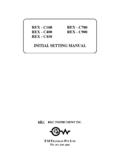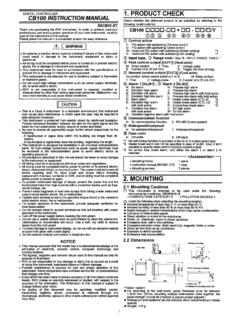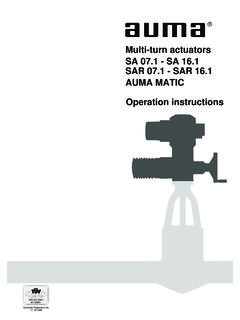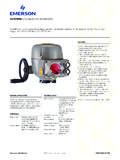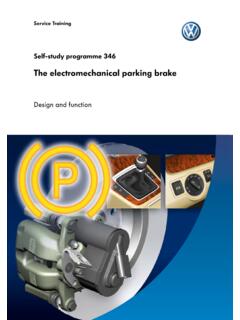Transcription of TM GCA121 Air damper actuators GCA32.. - FM FRANKLIN
1 Siemens Building TechnologiesCM2N4613E / & Staefa Division1/104613 OpenAirTMAir damper version, two-position control,with spring return, AC 24 V or AC 230 VElectromotive rotary actuators for two-position control, nominal torque 16 Nm,spring return to fail-safe position, operating voltage AC 24 V or AC 230 V, for two-position control, span mechanically adjustable between , pre-wired m long connection variations with adjustable auxiliary switches for control air dampers in ventilating and air conditioning plants using a nominal torque of 16 Nm for damper surfaces up to 3 m2, friction-dependent. requiring fail-safe position (zero position) when there is a power failure. Direction of rotation (right or left) determined by the actuator 's mounting on thedamper shaft. As soon as an operating voltage of either AC 24 V or AC 230 V is applied, theactuator turns to " 90 ".In the event of power failure or when the operating voltage is shut off, the actuatorspring returns to the fail-safe position 0.
2 The position indicator located on the shaft adapter displays the rotational angle positionof the damper actuator can be turned to any position using a hex wrench and locked using ascrewdriver. After mechanically releasing the lock or after briefly applying operatingvoltage, the actuator returns to the 0 rotational angle of the shaft adapter can be limited to 5 increments between 0 and 90 .UseFunctionsBasic functionsRotational movementFail-safe functionPosition indicationManual overrideMechanical limitation ofrotational angleCM2N4613E / Building Technologies2/10 Landis & Staefa DivisionAuxiliary switches provide supplementary functions. The switching points for switches Aand B (one changeover switch each) can be set independently in increments of 5 withinthe 0 ..90 rotational to "Technical design", "Commissioning notes" and "Internal diagram".Operating voltageAC 24 VAC 230 VStandardapplicationWith 2 auxiliaryswitchesStandardapplicationWith 2 auxiliary switches cannot be integrated retroactively.
3 For that reason, order therespective type that contains the desired to various mounting options depending on the direction of rotation and shaft length,separate parts such as the shaft adapter with position indicator and other mountingparts are shipped separately with the actuator comes with m long pre-wired connection following accessories and spare parts are available for function upgrades of theactuators; see data sheet N4699:Accessories Rotary/linear set for duct Rotary/linear set for wall Rotary/linear set with Rotary/linear set with lever and mounting Bracket for Weather parts and ordering information as per data sheetN4699 These actuators can be connected to all regulating and controlling devices with a two-position output supplying a switching voltage of AC 24 V or AC 230 brushless DC motor provides accurate speed control, torque monitoring to protectthe actuator and dampers as well as a reliable fail-safe supply the fail-safe function.
4 The problems caused by conventional frictionalgrip for multi-stage gearing are solved using a second, synchronously turning spring inthe motor which eliminates the motor s frictional auxiliaryswitchesSummary of typesOrderingDeliveryConnection cablesAccessories andspare partsEquipmentcombinationTechnical designMotor technologySpring returnmechanism in the eventof power failureSiemens Building TechnologiesCM2N4613E / & Staefa Division3/10 The illustration below shows the adjustable switching values for auxiliary switches A andB in relation to the rotational position forshaft adapter/positionindicatorActuator scaleSetting increments: 5 Switching hysteresis:2 Adjustment span forswitches A and BAB-5 0 10 20 30 70 80 90 0 10 20 30 70 80 90 4637D0380706050B90 Aux SwitchAdjustment203040102040A704637Z07 The setting shafts for the auxiliary switches turn together with the actuator . The scalesare valid only for the zero position of the , lightweight all metal housing made from aluminum diecast which guarantees along actuator life even under extreme ambient and noise-free gear train with stall and overload protection for the lifeof the spring has a factory set preload of 5 which ensures tight close-off for the wrench lock in the center of the actuator allows the manual setting of the gears.
5 A hexwrench is actuator can be fastened to shafts with various diameters and in various shapes(square, round) using just one screw due to the L&G patented the shaft adapter from either side into the opening for the shaft adapter dependingon the damper shaft length. For short shafts, the shaft adapter is on the duct shaft adapter coupling and the shaft holding are coupled via double-sided limitation of the rotational angle can be adjusted in the span of in incrementsof 5 .A metal strip with bolt serves to fasten the actuator on the opposite side of the actuators come with pre-wired m long connection can mount the actuator on either side depending on the required rotation setting and operating elements are available on both sides of the supplementary functions, the auxiliary switches A and B can be adjusted on theactuator front, below the opening for the shaft auxiliaryswitch(type-specific)NoteMechan ical designBasic componentsHousingGear trainSpring preloadManual adjustmentSelf-centering shaftadapterMechanical limitation ofthe rotational angleMounting bracketElectrical connectionNoteType-specific elementsAuxiliary switchesCM2N4613E / Building Technologies4/10 Landis & Staefa DivisionRefer to "Technical design" and "Commissioning notes" in this data - 5 1 Housing2 Angle of rotation scale 0.
6 90 3 Wrench lock for manual override4 Connection cable for power supply5 Connection cable for auxiliaryswitches6 Stop shaft for gear train7, 8 Adjustment dials for auxiliary switches A and B9 Position indicator10 Self-centering shaft adapter11 Locking ring for shaft adapter12 Adapter for position indicator13 Mounting bracket4613Z1511104613Z1694613Z171011124 613Z189 Setting and operatingelementsArrangement for longshaft adaptersArrangement for shortshaft adaptersSiemens Building TechnologiesCM2N4613E / & Staefa Division5/10 The basic system data for the control systems in use contains all engineering all the engineering notes before mounting, wiring, and commissioning the actuatorand pay special attention to all safety actuators must be used in a system only for applications as described in thebasic system data documents for the applied control systems. Additionally, all actuatorspecific features and rules must be observed as described in the brief description on thetitle page of this data sheet (bold print) and in the chapters "Use", "Engineering notes",and "Technical data".
7 All paragraphs marked with the special warning triangle as illustrated on the left containadditional safety information and limitations that must be observed under anycircumstances to avoid physical injuries or damages to actuators must only be used with safety extra-low voltage (SELV) or protectionby extra-low voltage (PELV) in accordance with HD actuators are double-insulated and do not provide a connection for the either line voltage or safety extra-low voltage for auxiliary switches A and B. Donot mix the two for operation. Howerver, operation using various phases is not open the actuator !The actuator is maintenance-free. Maintenance work may only be conducted by themanufacturer. Electric: Electric parallel connection for the same actuator types is permissibleprovided the operating voltage is within the required tolerance. Voltage drops at thefeed lines must be included. Mechanical: On using the bracket for Powerpack , the actuators may bemounted on the same damper quantity of actuators required depends on several torque factors.
8 After obtainingthe damper torque rating (Nm/m2) from the manufacturer and determining the damperarea, calculate the torque required to move the damper as follows:Total Torque = Torque Rating damper AreaNumber of actuators = Total damper Torque requiredSF x actuator Torque (Refer to Specifications)11 Safety Factor: When calculating the number of actuators required, a safety factor should be included forunaccountable variables such as slight misalignments, aging of the damper , etc. A suggested safety factoris (or 80% of the rated torque). Use safety insulating transformers with double insulation in accordance withEN 60 742; The transformers must be made for 100% runtime. Observe all local safety rules and regulations pertaining to sizing and protectingtransformers. Determine the transformer s power consumption by adding the power consumptionin VA for all actuators to "Commissioning notes" and "Internal diagram" in this data sheet as well as tothe HVAC job notesSTOPP roper use AC 24 V supply Auxiliary switches A,B AC 230 V supplyWarning,maintenanceParallel connection ofactuatorsRequired actuatorsCalculating the requiredactuatorsSizing transformersfor AC 24 VWiring andcommissioningCM2N4613E / Building Technologies6/10 Landis & Staefa DivisionAll information and steps to properly prepare and mount the actuator are listed in theMounting Instruction guide M4613 delivered with the actuator .
9 The shaft adapter as wellas all other individual parts are not pre-mounted as the actuator components are puttogether differently depending on the direction of rotation (right or left) and the dampershaft length. Refer to "Mechanical design" in this data the mounting position so that you can easily access the cables as well as thesetting dials on the front of the actuator . Refer to "Dimensions".In order to satisfy the requirements as per IP54, the following mounting conditions mustbe fulfilled: Mount the actuators only vertically (cabling see below) for air dampers with horizontalshafts. When the actuator is mounted directly on the damper shaft, the mounting angle my bea maximum of +/- 45 . Use the weather shield for mounting in any other you mount the actuator directly on the damper shaft, the mounting bracket must beused. The insertion depth for the shaft into the housing must be sufficient on minimum length and diameter for the damper shaft is listed in "Technicaldata".
10 The actuator is shipped with a 5 preload which ensures closing pressure for the necessary, you can limit the rotational angle in increments of 5 for the entire span bypositioning the shaft adapter in the respective mounting sets which are used to change the rotational movement into a linearstroke as described in "Type summary" are mounted information necessary for commissioning is contained in the following: This data sheet 4613 Mounting instructions M4613 Job diagramCheck to ensure that all permissible values as contained in "Technical data" areobserved. Check for proper mounting and to ensure that all mechanical settings are inaccordance with the plant-specific requirements. Additionally, ensure that thedampers are shut tight when in the closed position. Fasten the actuator securely to avoid side load. Check the rotation direction: Manually change the damper position by turning thegearing using a plug-in hex wrench in accordance with the mounting instructions.
